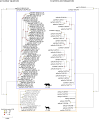Diversity of selected toll-like receptor genes in cheetahs (Acinonyx jubatus) and African leopards (Panthera pardus pardus)
- PMID: 38355905
- PMCID: PMC10866938
- DOI: 10.1038/s41598-024-54076-y
Diversity of selected toll-like receptor genes in cheetahs (Acinonyx jubatus) and African leopards (Panthera pardus pardus)
Abstract
The anthropogenic impact on wildlife is ever increasing. With shrinking habitats, wild populations are being pushed to co-exist in proximity to humans leading to an increased threat of infectious diseases. Therefore, understanding the immune system of a species is key to assess its resilience in a changing environment. The innate immune system (IIS) is the body's first line of defense against pathogens. High variability in IIS genes, like toll-like receptor (TLR) genes, appears to be associated with resistance to infectious diseases. However, few studies have investigated diversity in TLR genes in vulnerable species for conservation. Large predators are threatened globally including leopards and cheetahs, both listed as 'vulnerable' by IUCN. To examine IIS diversity in these sympatric species, we used next-generation-sequencing to compare selected TLR genes in African leopards and cheetahs. Despite differences, both species show some TLR haplotype similarity. Historic cheetahs from all subspecies exhibit greater genetic diversity than modern Southern African cheetahs. The diversity in investigated TLR genes is lower in modern Southern African cheetahs than in African leopards. Compared to historic cheetah data and other subspecies, a more recent population decline might explain the observed genetic impoverishment of TLR genes in modern Southern African cheetahs. However, this may not yet impact the health of this cheetah subspecies.
© 2024. The Author(s).
Conflict of interest statement
The authors declare no competing interests.
Figures




Similar articles
-
Genomic analyses show extremely perilous conservation status of African and Asiatic cheetahs (Acinonyx jubatus).Mol Ecol. 2022 Aug;31(16):4208-4223. doi: 10.1111/mec.16577. Epub 2022 Jul 17. Mol Ecol. 2022. PMID: 35748392 Free PMC article.
-
PREVALENCE OF VALVULAR REGURGITATIONS IN CLINICALLY HEALTHY CAPTIVE LEOPARDS AND CHEETAHS: A PROSPECTIVE STUDY FROM THE WILDLIFE CARDIOLOGY (WLC) GROUP (2008-2013).J Zoo Wildl Med. 2015 Sep;46(3):526-33. doi: 10.1638/2014-0155.1. J Zoo Wildl Med. 2015. PMID: 26352956
-
Phylogeography, genetic structure and population divergence time of cheetahs in Africa and Asia: evidence for long-term geographic isolates.Mol Ecol. 2011 Feb;20(4):706-24. doi: 10.1111/j.1365-294X.2010.04986.x. Epub 2011 Jan 8. Mol Ecol. 2011. PMID: 21214655 Free PMC article.
-
Conservation Genetics of the Cheetah: Lessons Learned and New Opportunities.J Hered. 2017 Sep 1;108(6):671-677. doi: 10.1093/jhered/esx047. J Hered. 2017. PMID: 28821181 Free PMC article. Review.
-
Understanding the Role of Semiochemicals on the Reproductive Behaviour of Cheetahs (Acinonyx jubatus)-A Review.Animals (Basel). 2021 Nov 3;11(11):3140. doi: 10.3390/ani11113140. Animals (Basel). 2021. PMID: 34827872 Free PMC article. Review.
Cited by
-
Comparative genomics of the Natural Killer Complex in carnivores.Front Immunol. 2024 Oct 3;15:1459122. doi: 10.3389/fimmu.2024.1459122. eCollection 2024. Front Immunol. 2024. PMID: 39421739 Free PMC article.
References
MeSH terms
Grants and funding
LinkOut - more resources
Full Text Sources
Medical

